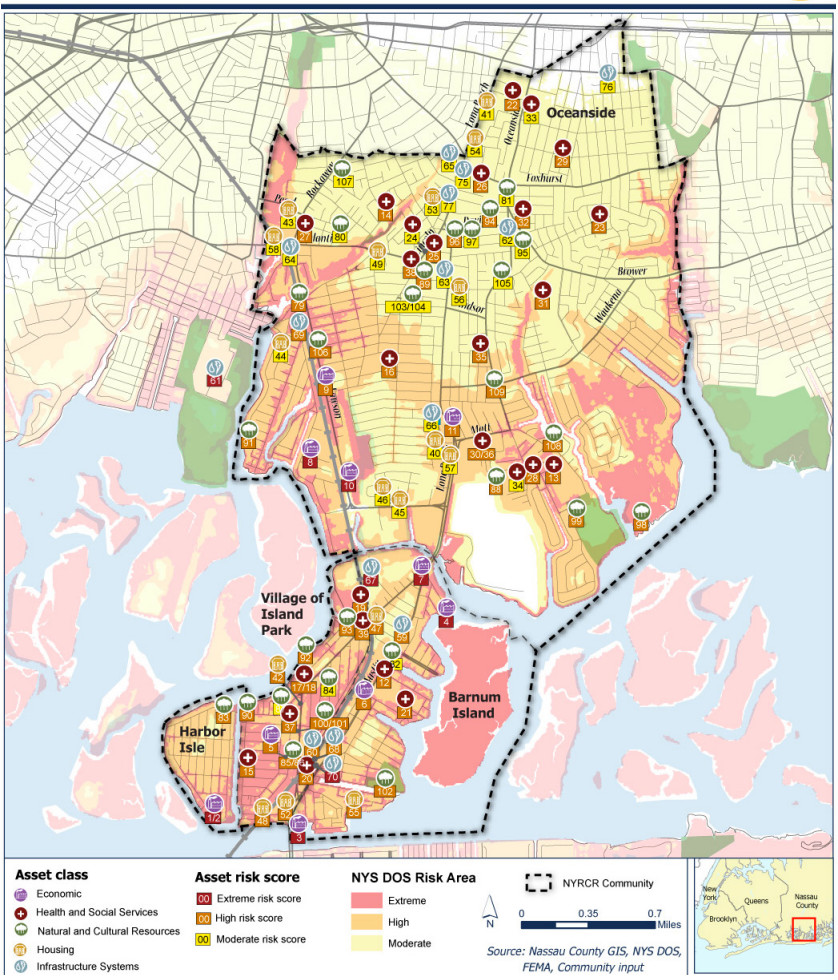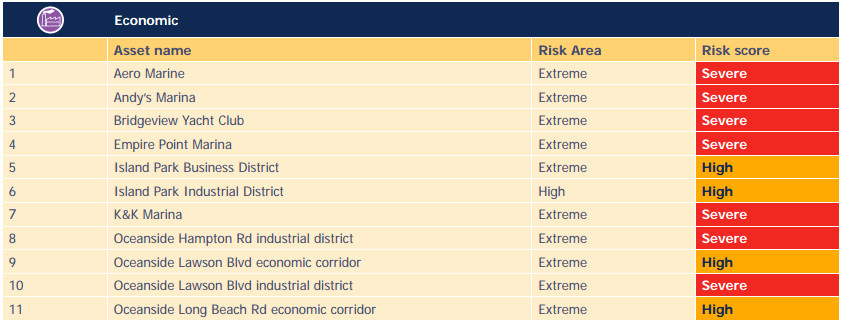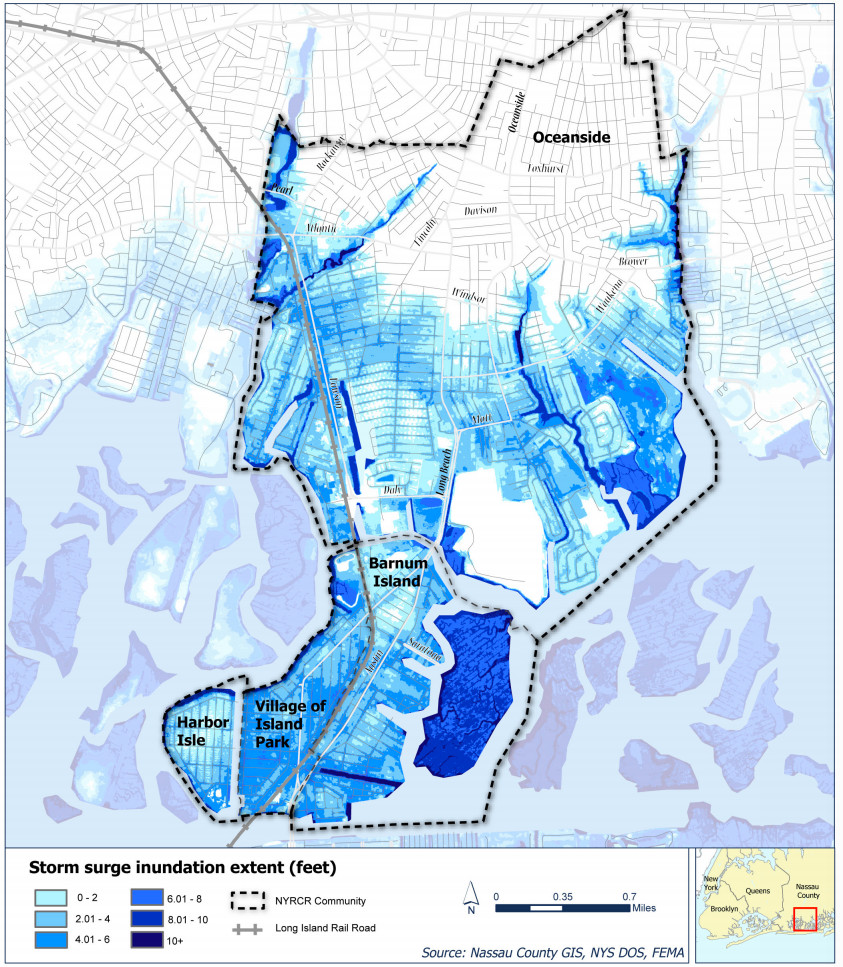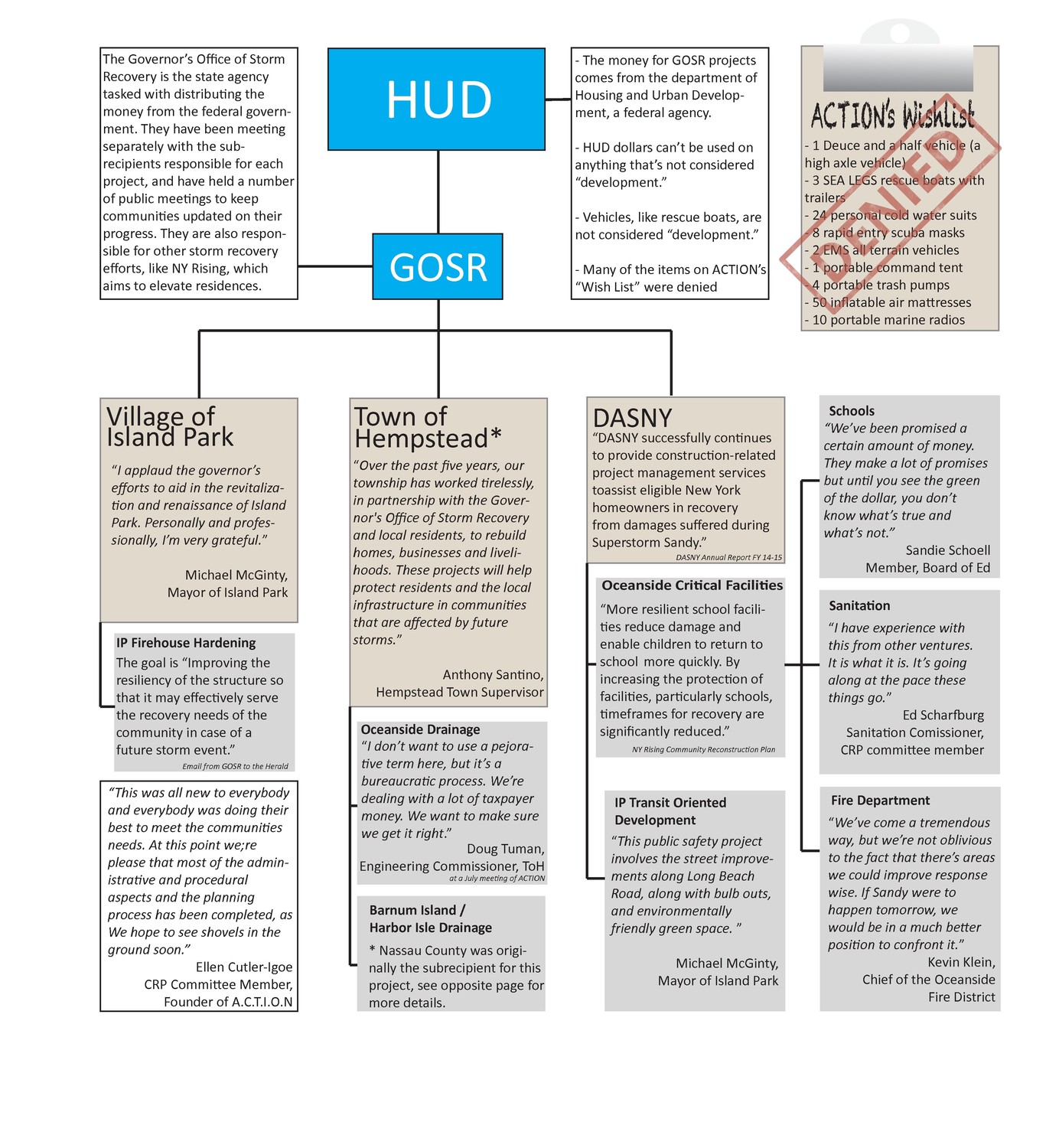Surviving the next superstorm
Recovery and resiliency projects in Oceanside and Island Park
After Hurricane Sandy devastated the Oceanside-Island park area, local activists, and local and state officials, began working on a plan to make sure a storm would never again leave behind so much damage.
Five years later, the five projects under the auspices of the Governor’s Office of Storm Recovery are moving along at a pace that GOSR officials themselves have described as “glacial.” At a July presentation, Ocean siders expressed their displeasure at the slow trickle of information about the projects and suggested that the Herald update the community more frequently, and with more detail, than GOSR’s own quarterly reports.
The following are summaries of the projects that are under way in Oceanside and Island Park, and on Barnum Island and Harbor Isle — on the storm’s five-year anniversary.
Oceanside critical facilities
GOSR has worked separately with school, sanitation and fire officials to plan and implement improvements to their facilities, and has budgeted a total of $8.7 million for these projects, which consist of hardened doors to prevent flooding, and generators to power relief and recovery efforts.
At this point in the process, each of the three facilities has reached the “30 percent design phase,” which means that officials have narrowed the scope of their project from lists of possible improvements assembled by GOSR officials, in coordination with H2M, an engineering and architecture firm that was awarded a contract for the work.
Schools
Budget: $3.8 million
According to Bob Transom, the head of the Oceanside Board of Education’s building committee, the process has been going smoothly, but he is watching the clock. “I’m concerned we’re approaching the drop-dead date for a certain phase,” Transom said.
At this point, the school district, working with GOSR and H2M, has “finished the design, and now we’re just reducing scope,” Transom said, adding, “We don’t want to get something that can’t be used, or something that can, but isn’t cost-effective.”
Improvements to the schools would include flood-mitigation doors and “storm planks,” which, according to the minutes of a July meeting of GOSR and the School District, require “significant” space for storage. A representative of the state Dormitory Authority noted that “the project specifications will include language relating to the training required to properly store, protect, maintain and install the plank materials.”
After a walkthrough of district schools before the July meeting, the scope of the projects doubled from 33 doors being considered for hardening to 66.
Fire Department
Budget: $4.2 million
The Oceanside Fire Department has undergone a number of significant changes since Sandy, with funding from a number of sources, including the county, town and GOSR-regulated Community Development Block Grants. After the storm, Chief Kevin Klein said, “We reviewed the entire district response to Sandy … and we started a committee to make a list of ways we could improve.
“We’ve come a tremendous way, but we’re not oblivious to the fact that there’s areas we could improve, response-wise,” Klein continued. “If Sandy were to happen tomorrow, we would be in a much better position to confront it.”
“Foxhurst is high and dry,” he said of the department’s headquarters — but it would not be large enough to accommodate additional firefighters and vehicles if they were brought in to assist with a cleanup. Fire officials plan to add two additional bays and a rooftop antenna to ensure good communication. A replacement generator is also slated for Terrace Hose Company No. 3, and the roof at Columbia Engine company has planned repairs.
Sanitation
Budget: $700,000
Oceanside’s sanitation department is set to move forward on items it chose from a list of suggestions proposed by GOSR. According to Ed Scharfburg, public liaison for the sanitation board and a member of the original CRP committee, the district prioritized the protection of its mechanical and electrical equipment in the basement of its headquarters, as well as a partial replacement of the building’s roof, following an asbestos study.
The work would include sealing a basement window, and installing a ventilation system and storm-proof basement doors.
Scharfberg said he wasn’t surprised by the pace of reconstruction work. “I have experience with this from other ventures,” he said. “… It’s going along at the pace these things go.”
Drainage improvements
Budget: $13.5 million
Improvements to Oceanside’s drainage system will include a series of road elevations, check valves and other improvements that will increase the system’s capacity to transport and retain flood water. This project is being carried out by the Town of Hempstead’s engineering department, which in July presented the results of a study on the issue, with recommended interventions.
Check valves
Check valves, or backflow valves, ensure that seawater doesn’t enter the drainage system. According to the CRP, one problem Oceanside faced was the “tidal surge [that] overwhelmed Ocean side’s storm water system.” Water rose above the system’s outfalls, flowing back into the pipes and out through storm drains in low-lying areas. The check valves are intended to prevent this.
The check valves for Oceanside, Barnum Island and Harbor Isle will be designed and installed in conjunction with those planned for Bellmore, Merrick Wantagh and Seaford. The Town of Hempstead has issued a request for proposals on this project.
Road raisings
According to the town’s engineering department, an ideal road raising elevates a roadway to above the “new moon high tide” waterline. Before the town can begin the work, it must notify and get consent from all residents on the road who would be affected by the driveway adjustments required of the project. The town has said that homeowners will not bear the cost of work that has to be done on their property.
Other drainage improvements
The study also found that flooding in Oceanside could be reduced by increasing pipe capacity in certain spots, repairing some damaged pipes and adding “water retention systems,” which would allow drains to take on more water.
Island Park transit-oriented development
Budget: $500,000 to $1 million
According to a quarterly GOSR newsletter, this project “intends to create a mixed-use, transit-oriented development plan to revitalize Island Park’s downtown and waterfront to attract visitors, residents and new businesses. … This project will promote the growth of the Village’s commercial district and encourage further investment in the downtown area to strengthen the local economy and increase its resiliency in the face of future storm events.”
Island Park Mayor Michael McGinty said that the project consists of “street improvements along Long Beach Road, along with bulb-outs and environmentally friendly green space.” Bulb-outs, or sidewalk extensions that jut out into intersections, make it easier for drivers to see pedestrians. They will also contain plants to help with drainage.
Island Park Fire Department hardening
Budget: $500,000
According to McGinty, the “second floor of the firehouse is the village’s emergency management center,” and this project involves “hurricane-proofing the second floor.”
According to the CRP, “The Village of Island Park Firehouse sustained substantial damage during Superstorm Sandy. The building flooded, causing damage to the electrical and mechanical systems, and several vehicles were lost. The foundation may have suffered structural damage.” Additionally, the firehouse was unable to accommodate the 150 outside firefighters who assisted in the village’s rescue and recovery efforts.
When McGinty spoke with the Herald, H2M’s structural engineers were still evaluating what needed to be done at the firehouse and preparing for the design phase.
Barnum Island/Harbor Isle drainage improvements
Budget: $7.6 million
Originally, Nassau County was responsible for the Barnum Island/Harbor Isle improvements and brought these projects to the 30 percent design phase. On Oct. 20, the county transferred the funds and the responsibility for the project to the town, which controls the majority of property in the area.
The CRP states that “In Barnum Island, the worst flooding occurred near the California Place Canal … with up to eight feet of water entering homes and businesses.” The roadways near there, and in other particularly hard-hit areas, are slated for elevation, and a number of check valves are set to be installed.

 39.0°,
Fair
39.0°,
Fair 











